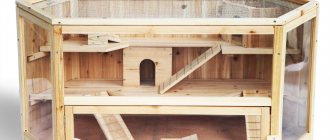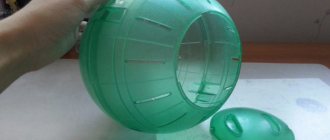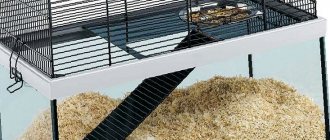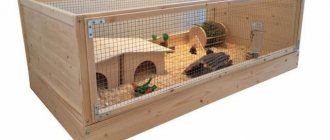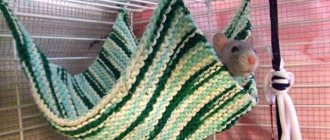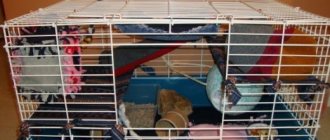Pet stores offer a fairly wide selection of cages for rats. But it is really difficult to find a model that is suitable both in size, design, internal arrangement and price. The best solution to this problem is a DIY rat cage. By making it yourself, you can choose a suitable design and make sure that your pet will live in comfortable and safe conditions. Properly selected materials will help you save money and get a durable, comfortable cage without breaking the bank.
At the first stage of creating a cell, you need to decide on the cell model
Requirements for a rat cage
Decorative rats are usually very affectionate and sociable. They are highly trainable. However, in order for the pet to feel good, be cheerful and cheerful and live longer, it is necessary to create comfortable living conditions for it. There are a number of requirements for rat cages. They relate to the size of the home, the materials from which they are made, the internal arrangement and the safety of animals.
Did you know? It has been proven that the intelligence of rats is quite high - they are smarter than cats. These animals are able to establish cause-and-effect relationships between phenomena and anticipate future events.
The basic requirements are as follows:
- resistance to sharp rodent teeth;
- lack of opportunity to escape;
- minimal risk of injury.
What should be the size and shape
Despite the small size of the animal, it needs to choose a spacious home. This is a necessary condition for the normal development and well-being of an animal that is active by nature. Living in cramped conditions threatens the rat with a bad mood, constant stress and frequent illnesses. The ideal cage option is multi-level.
We recommend finding out how long rats live at home.
In such a home the pet will have a place to roam, play, run, and perform various tricks. It is strictly forbidden to keep a rodent in a flat cage. One animal will be comfortable in a home with the following minimum dimensions: height - 50 cm, width - 40 cm, length - 60 cm. The recommended distance between the rods is 1.7 cm.
Material
Only a dwelling with metal bars is suitable for a rodent. They may be galvanized or not. Since these animals love to litter, there must be a tray in the cage. It will make cleaning faster and easier. A plastic tray is best washed and disinfected.
Wooden bars and rat cage floors are not a good option. An animal can easily chew through them.
Aquariums are also not suitable for these rodents. Heat and gas exchange are disrupted in them, which negatively affects the health of the animal. After all, the animal will constantly inhale fumes from its feces, and ammonia vapor will begin to penetrate into its lungs. In addition, the temperature in aquariums is high, which can lead to overheating of the body.
Plastic dunes are not the best option for rats . The conditions in them are the same as in aquariums. They are suitable only for short-term keeping of a newly born female with babies, as they ensure their safety.
What structures cannot be used
Many rat breeders mistakenly believe that any jar or box is suitable for small animals to live in. However, it is not. To protect your furry from stress and discomfort, you should not place your pet in the following types of housing:
- Glass jars, aquariums and terrariums - such containers have solid walls, so soon after moving in the rat will feel a severe lack of air. There are many examples of rodents simply suffocating in aquariums.
- Carton boxes. The rat will run away from such a dwelling at the first opportunity. In addition, air exchange in boxes is also difficult.
- Plastic containers are only suitable for keeping the rat inside temporarily, for example during transport. Because after 30-40 minutes the animal will also begin to suffer from a lack of oxygen.
Also, you should not choose low cages designed for keeping mice or small hamsters as a home for a rat. Rats are quite freedom-loving, so they do not do well in confined spaces.
Advantages and disadvantages of a homemade cage
Of course, it is easier and faster to purchase a ready-made home. However, a home-made cage has its pros and cons.
Also find out what you feed your rat.
Among the advantages are the following:
- Price . If you make a house for an animal from scrap materials that are already in the house, then it will cost much less than buying it.
- Manufacturing according to the characteristics and appearance of the home interior. It is possible to make housing for an animal of any shape and size so that it fits harmoniously into the interior of an apartment or house. Also, according to our own design, it is possible to place doors, shelves, ladders, wheel mounts and hammocks inside the cage.
The disadvantages include:
- Low level of aesthetics. It is not always possible to make the cage look beautiful when making it yourself.
- Wasting your own time. It takes significantly less time to purchase a cell than to manufacture it.
Working with galvanized mesh
In addition to the frame, the rat cage must also contain a lattice, which, in fact, will keep the animal locked up. Otherwise, the apartment of the happy owner will be in chaos and destruction. Just like any house, a cage consists of four walls, a floor and a ceiling. Almost everything except the pallet will be created from galvanized mesh. And this means that you have to work hard. First you need to mark the walls. They should be as tall and wide as a frame. That is, everything should fit together perfectly. The marks have been set - let's get to work. To cut the mesh accurately, you need good and sharp tools.
Wire cutters are suitable for this task. Galvanized mesh must be cut step by step, section by section. You constantly need to measure what is cut off: parallel walls must be the same. Otherwise, the cell will bend in different directions like a wave. But this will not increase comfort in any way, and the appearance will be sloppy. Well, if the walls are already cut, they should be prepared for further use. First, sand down all edges, tips and nicks. Protruding shoots should also be removed. Sanding work can be done with sandpaper. He will do this task well. Secondly, the cut galvanized mesh needs to be painted. This will protect the cage from rusting and from quickly losing its presentation. You can paint the mesh with regular enamel.
How to make a cage with your own hands
Making a rat's home should begin with calculations and drawings. It is important to consider the correct dimensions for the required number of animals. Each individual should have 50 cm³ of free space. You should also determine what material all parts will be made of.
We advise you to read what to feed and how to care for a decorative rat.
Preparation of the drawing
To make the cage neat and comfortable, it is important to draw up a detailed drawing. It should indicate the dimensions of each part of the structure and the placement of fasteners. They must be precisely calibrated. Only under this condition will the assembly of the cell be easy, and its best final appearance will be ensured.
People who have already made structures themselves can make their own drawings. It is also possible to use ready-made diagrams posted on the Internet.
Required tools and materials
If you take the standard version of the cage with metal bars, you will need to stock up on a certain set of tools and materials.
Important! When choosing paint, preference should be given to the least toxic options.
The following items should be on hand:
- pliers;
- side cutters;
- file;
- galvanized mesh with cell sizes 19×19 mm (preferably painted);
- aluminum wire 1.5–2 mm thick;
- rigid wire 1.5–2 mm thick;
- polyvinyl chloride sheet 1×1 m, 4 mm thick.
When using unpainted mesh, you will also need a brush, white spirit, primer, and metal paint. The last two elements can be replaced with galvanized paint.
Step-by-step construction instructions
The process of making a homemade cage according to the described instructions is not difficult.
Important! Animals should not be allowed into the cage immediately after its manufacture. You must wait at least a week until the harmful vapors from the glue evaporate.
It is important to follow these step-by-step instructions:
- Using side cutters, cut 4 walls, a roof and a false bottom from the mesh according to the dimensions indicated in the drawing.
- Make holes for doors in the roof and walls.
- Check the parts for dangerous elements - roughness, sharp protrusions.
- Perform grinding.
- Cut the wire into pieces of 4-5 cm.
- Connect all the parts by winding these parts, making 2-3 turns.
- Clamp the ends with pliers.
- Attach the shelves in the same way.
- Attach the clamps to the doors using stiff wire.
- If the mesh is not painted, paint it. It should first be degreased using white spirit. This will allow the paint to adhere better and last longer.
- Cut out the polyvinyl chloride pallet, cutting it to the same size as the base and leaving a margin of 1 cm on each side.
- Glue to each side of the side, 12–15 cm high.
- Glue strips inside on each side that will serve as the base for the cage.
- To strengthen large structures, glue 5 stiffening ribs and corner covers 10 cm wide and a height equal to the height of the side to the pallet. The last reinforcement is glued with an overlap.
- Glue the legs to the corners of the pallet.
- If possible and willing, you can attach wheels to the legs.
Theoretical beginning
If the question is asked: “How to make a cage for a rat with your own hands”? – then it’s worth starting with theory. Namely, from the outline of the diagram. After all, without a drawing, not a single carpenter will get down to business. In this case, the diagram will help take into account the materials used.
Just about them. For the job you will need wooden blocks about three centimeters thick, nails, screws and galvanized iron mesh with a diameter of no more than twenty millimeters. Rats crawl well even in the narrowest places, so holes with a large diameter will not keep the animal locked up. When constructing, you need to consider the correct size of the rat cage. The height must be at least eighty centimeters. This parameter will facilitate the construction of a second floor. In addition, rats do not like cramped spaces. The width of the cage will be at least forty centimeters. You need to place toys and tunnels somewhere. The length of the cage will not exceed seventy centimeters. With such dimensions, the animal will not feel cramped. The rat will run and frolic. A little advice. These data are given for the residence of one rat. If in the future a friend or girlfriend joins the animal, then you need to increase the area of the structure from the very beginning. Not twice, of course, but you need to add ten centimeters to the above data.
What should be in the cage and how to arrange it correctly
Since rodents spend more time in their home, it must be properly arranged and equipped for a pleasant, comfortable stay and pastime. The main activities that a rat does every day are sleeping, eating, physical activity, and going to the toilet. Each of them will require a specific place and equipment.
Familiarize yourself with the behavior, care and nutrition of rats at home.
Here is the minimum set of things that should be in the cage:
- for relaxation - a hammock (open and closed), a house, a shelf, a satellite house, a bed;
- for food and water intake - 2 feeders for dry and succulent food, a drinking bowl;
- for going to the toilet - a container and a tray filled with filler;
- for physical activities - ladders, perches, hanging toys, bells, tunnels.
Each of these accessories should be installed in a specific area of the cage.
Interior arrangement
The conditions in which a pet is kept have an impact on its mood, well-being and character. It is very important to set up a rat's cage without harming it.
First you need to take care of the filler: wood shavings, compressed corn filler or non-colored paper will do.
The following items must be present in the cage:
- Food bowls: heavy ceramic or metal hanging;
- Drinking bowl. A ballpoint with a metal spout will come in handy. It is attached to the outside of the mesh, and the spout is pushed inside;
- Hammock. Soft hanging hammocks are very popular with rats;
- House: serves as a place where the rodent hides or rests;
- Toilet: ceramic or plastic dishes in the corner of the rack.
The best distance between drinkers is 150-200 mm. They are installed on different shelves, and the rat can easily jump to them or reach them by standing on its paws.
A plastic or lattice plate on the floor is a place for your pet to rest. This makes it easier for him to observe what is happening in the room and at the same time relax.
For entertainment, rats like swings, ropes with a knot at the end, wooden toys, etc. Walking balls and a running wheel are not suitable for pets (due to curiosity and a long tail).
The simplest toys.
It’s quite easy to make toys for rats with your own hands. Here are the simplest options for such toys:
Plastic labyrinth. Buy plastic pipes for sewerage, connect them together with PVC tubes or hoses in the form of a labyrinth.
Fabric labyrinth. Take any scrap fabric, such as an old sheet or towel, and throw it over the rats. Wrap it up so that your pets have to make an effort to find a way out. Rats can chew holes in fabric, so it's best to use items that you won't mind throwing away later.
A labyrinth of dirty laundry. Place your pets in a basket or drawer with dirty laundry. The animals themselves will dig passages and holes in it, exploring unfamiliar smells and climbing to the very bottom of the box. But be careful: if you leave them unattended for a long time, the rats can damage the laundry and gnaw holes in it.
Stone. Take a large stone and place it in the cage. Animals will explore a new object, try to dig under it, sniff from all sides - and will occupy themselves for quite a long time. This toy for rats has one more undoubted advantage: crawling on the stone, the animals will grind their claws on its surface.
- House made from newspapers. Stack up several old newspapers. Roll some of the newspapers into a tube, placing pieces of treats for rodents between the newspaper sheets. Your pets will love searching for treasures in their new house.
- Napkins. Place a pack of paper napkins in the rats' cage. One or two napkins can be pulled out from the package so that the animals can quickly guess what they can do with the new toy. It will take the rats very little time to pull out all the napkins, and they can easily use the remaining packaging as a new house.
- Rat football. Take some table tennis balls. Throw these rat toys into the cage. Your pets won't be able to bite through them, but will have a lot of fun chasing them around the cage.
- Closet. Remove all foods and items dangerous to animals from the kitchen cabinet. Release the rats there. The new space is full of unknown smells, and curious animals will happily explore it.
- Climbing wall. Take pieces of old grating, plastic or metal. Mount them on the wall so that your animals can crawl on them comfortably.
Domestic rats are very active and curious animals. They will get bored sitting in a cage all the time. In order to somehow limit the movement of animals around the apartment and at the same time keep them occupied in your absence, you can create a real small town for them from scrap materials.
Practice time
A do-it-yourself rat cage should be no different from a purchased one. Therefore, you need to build conscientiously, because just give small animals a chance, and they will immediately run away. First you need to construct a wooden base that will hold its shape.
The cube must acquire the above parameters. You need to cut the blocks carefully so that there are no nicks or cracks. It is better to remove excess irregularities after finishing with a saw using medium-grit sandpaper. So the edges will not be sharp, and the building will take on a completely new, neat look. Before moving on to another stage of work, it is worth taking care of the tree. It needs to be processed somehow. Ordinary construction varnish works great. You need to varnish in two steps. The first time, the wooden parts need to be well varnished and dried. The second time, for reliability, the wood should be varnished again, but with a thinner layer. The wooden frame has dried - then you need to move on to the next stage.
Important stage
A rat cage is more than just a house. This is a place where the animal rests body and soul. That is why it is so important to maintain harmony when building this cage. After all, a lot depends on the rat’s house.
For example, will the pet be comfortable? That's what makes it fun. Will the little rat be playful or withdrawn? Will he live a long and happy life? When building a house, many factors need to be taken into account. Size, shape, toys, add-ons and more. Therefore, it is important to adhere to simple rules: accuracy and quality.
Briefly about the main thing
Even for inexperienced craftsmen, there will be no problems with the question of how to make a cage for rabbits if you strictly follow all the instructions and recommendations.
To build a rabbitry, the dimensions of the future structure are first determined. It is advisable to start work by completing a drawing. Then a timber frame is constructed.
The next stage is the design of the floor. It can be made of metal profile, fine mesh cage or wooden slats.
After this, the plywood walls of the cage are made. The work is completed by decorating the roof and installing a tray where waste from the cage will fall.
A drinking bowl, feeder and hay barn are installed in the finished cage.
Ratings 0
Drawing plan
The first step in manufacturing is selecting the desired sample, drawing up a drawing and calculations.
There are many examples on the web with suitable designs for the job. They are made of several floors, because the animals run and climb well. The size and type of cell depend on the number of inhabitants.
For a pair of rodents you will need a house with dimensions of 600x400 mm for the base, and 600-1000 mm for the height. For boys, 1-2 floors are enough: they are calmer and more sociable, and prefer to climb the floors using the owner’s hand. Girls are more mobile and shy; they will be happy with 3-6 floors.
The chance to make a rat cage with your own hands involves interior design of the home.
Places for ladders, booths, hammocks and beds provide rodents with comfort and travel through the racks. It is necessary to select a location for the doors in advance. This will speed up cleaning, help catch the animal when it “escapes” and simplify access to the sick rodent.
